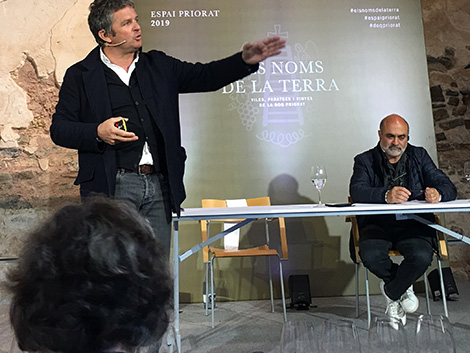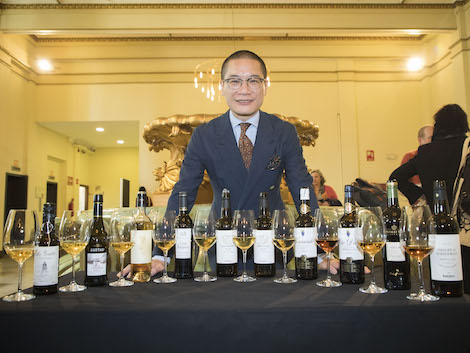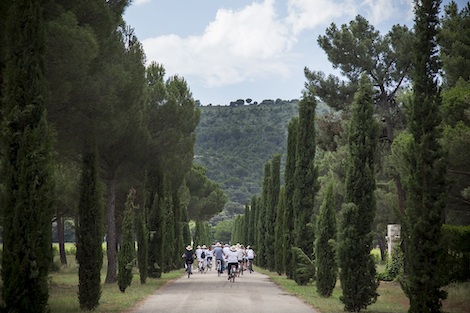
Called Els noms de la terra (The Names of the Land), DOQ Priorat’s new classification is the most ambitious ever carried out by any Spanish wine producing region alongside Bierzo in Castilla y León.
It strengthens the Burgundy-inspired model in Spain as opposed to Rioja’s traditional classification based on oak ageing times. It also goes much further than Rioja’s new village and single-vineyard wine categories.
A quality-oriented region
Priorat benefits from being younger and much smaller (2,010Ha against 65,000Ha) than Rioja given that this area in southern Catalonia was neglected and impoverished after phylloxera and during the 1960s and 1970s.
The renaissance of Priorat after the late 1980s came with the conviction that this rugged, steep region could only preserve its wine heritage if top quality, high-priced wines were made.
Since then, conditions have steadily improved. Priorat achieved its qualified appellation status (DOQ) in 2000 (preceded by Rioja in 1991) and was the first region to introduce village wines in Spain in the 2007 vintage.
As a member of the recently re-elected Board of Directors of the Regulatory Council, Álvaro Palacios is one of the driving forces behind the classification and a major influence as the region’s largest producer. Significantly, he is also behind the most expensive wine in a region (L’Ermita).
The names of the land
The best way to understand the new classification in Priorat is to think of it in Burgundian terms. At the base of the pyramid are regional wines; they can be produced with grapes grown throughout the appellation and are labelled DOQ Priorat. Since the 2007 vintage, vi de vila (village wine) is restricted to certain places approved by the Consejo. The novelty from the 2017 vintage are the vi de paratge (similar to climats or lieu-dits in Burgundy) and single-vineyard wines which will be labelled either as vinya classificada (a sort of a premier cru) or gran vinya classificada (the equivalent of a grand cru).
The 459 paratges or sites (don’t panic; there’s no need to learn all the names by heart) are pieces of land with a certain identity whose names have been recovered “so that the wines can be called after their places of origin,” said president Sal-lustià Álvarez and Álvaro Palacios during the presentation for international and Spanish journalists and wine professionals at Espai Priorat.
The first wines that will become vinya classificada are those that held the vi de finca (single-vineyard) status under Catalonian law: Clos Mogador in Gratallops, Vall-Llach’s Mas de la Rosa in Porrera and two wines made by Viticultors Mas d’en Gil in their estate in Bellmunt: the white Coma Blanca and the red Clos Fontà. Álvaro Palacios’s L'Ermita will be the first wine to qualify as gran vinya classificada in the 2017 vintage. While this category requires a unanimous and long-standing market recognition, all vinya classificada involves a traceability of at least five years
As the Consejo’s secretary, Jaume Josa, pointed out, this classification “is not the only posible way, but it is the one which best suits the nature of small vineyards and low yields of our region.”
Defining the territory
Vineyard classification in Priorat started with vi de vila. The area of influence of each village transcended its administrative limits and was based on geological and climate factors as well as road maps from the area and the location where grapes were crushed. The vineyards of Porrera closest to Gratallops are a good case in point. Traditionally, their owners were growers from Gratallops who crushed the grapes in the village and travelled to these vineyards on roads that started in Gratallops. Even the area’s climate is warmer. All these factors meant that they were finally considered to be part of Gratallops.
The aim behind the paratjes is to define geographical areas in as much detail as possible. Technical data were sourced from the land registry and the Consejo, including geological, topographical and relief maps with slopes and exposures. This information was later checked by locals with a thorough knowledge of the area. They have looked for clues as to why a place is called in a certain way and whether its name is widely known in the area. An ambitious atlas with detailed maps and information of all the paratges is expected to be published soon, in line with Alessandro Masnaghetti’s work on Barolo.
The 459 sites represent the entire DOQ regardless of whether vineyards are planted on them or not. The first impression is that there are many repetitions. As many paratges were traditionally called aubagues (shady spots), solanes (sunny spots) or referred to the area’s orography (plana, coll, costes), the name of the village has been added to clarify. To what extent will the singularity of the names influence producers to adopt the category? Might these names be seen as an asset when it comes to communicate their wines? Aren’t shady sites (aubagues) part of the trend towards fresher wines? Álvaro Palacios’s Les Aubaguetes, for instance, is a single-vineyard red sourced from a north-oriented plot in Bellmunt.
The Consejo will also certify old vines provided they come from 75-year-old plots or were planted before 1945. Requests are being matched with aerial photographs taken in 1945 and subsequents images from 1955, 1986 and 1995.
As well as village wines, the new categories are being monitored from the 2017 harvest through an app linked to the Consejo. Producers must report all movements of wine -including grapes entering the cellar to racking, putting wine into barrels or transferring it to other vats or containers- so that the entire process can be traced. Will such tight controls discourage producers from adopting the new categories? Producers who make vi de vila have first-hand experience of the process.
A tasting commission formed by Spanish and international experts is also due to be established.
How will all this work?
The new classification will add considerable complexity to the marketing of Priorat wines. As with village wines, it is unclear whether producers will use these categories, particularly sites with names that have been previously registered as commercial brands.
The first case of a “shared name” is Mas de la Rosa. Used for a few years by Vall Llach for its top wine, it is now one of the 459 official sites. Torres, which recently purchased a vineyard on this site in Porrera, will soon launch its own Mas de la Rosa wine. In this regard, it is interesting to note that recent EU rulings favoured place names over registered brands.
Most producers we had the chance to talk to during Espai Priorat said they are likely to focus on classified vineyards. Some are also considering applying for paratge as a springboard to the single-vineyard category.
But there are exceptions. With his wine Voltons, Jordi Vidal from La Conrería d’Scala Dei wants to draw attention to the influence of the wind on this north-facing slope in La Vilella Alta. But his new white, Primera Vinya, sourced from Escaladei will be released as a village wine with the final aim to obtain the status of vinya classificada.
We have also learnt that a relevant producer like Scala Dei has applied for the gran vinya classificada status for Masdeu, the wine that comes from its most iconic vineyard at the top of the Montsant mountain. Álvaro Palacios won’t apply for the paratge designation for his wine Les Aubaguetes. Instead, he will wait five years to obtain the top distinction of gran vinya classificada. For its part, Clos Mogador expects its Manyetes Cariñena to become a vi de paratge in the 2018 or 2019 vintage.
Meritxell Pallejà, who makes a 100% Garnacha called Magran in the area of Manyetes, hopes to achieve the vi de paratge status when her vines reach the required age. In the meantime, she is hoping to get her red Torrent accepted as a vi de paratge. After laying the foundations with her entry-level red Nita, Pallejà wants to focus on specific plots and vineyards often resulting in wines made in tiny quantities (one barrel in some cases) but sold for around €35 to €40. “After the vi de vila, this is the next step up for wine lovers who want to learn more about the land, not necessarily wine experts.”
With 14 initial requests for vi de paratge, two of which also meet the requirements to be labelled as old vines, the appellation does not expect a flurry of requests although the recent presentation of the classification has brought in new applications. As far as the Consejo is concerned, the new classification aims is meant to clearly show the origin of the wines on the label.
Priorat and Bierzo: a comparison of classifications
No doubt Priorat’s relatively small size and quality-oriented approach helps to have a consensus. Moreover, leadership by producers like Álvaro Palacios (where else in Spain do you have the largest producer making the region’s most expensive wine?), René Barbier and president Sal.lustià Álvarez, who has always worked hard to bring prosperity to the community, have been key in the development of the new classification.
In this regard, Priorat is only comparable to Bierzo where Ricardo Pérez has played a similar role to that of his uncle Álvaro -both of them set up Descendientes de J. Palacios in the late 1990s.
The main difference between the classifications is that Priorat requires that vineyards are owned by producers or worked under at a seven-year rent contract in order to be labelled as vi de vila, vi de paratge or vi de vinya, while Bierzo empowers growers so that they can benefit from selling grapes from high-quality plots. Ricardo Pérez thinks that these growers might eventually be encouraged to start making their own wines.
Regulations in Priorat tend to be more restrictive. Current conditions still state that “subzone wines [that is, vi de vila] will be made in wineries located within the said subzone” -a rule that we have criticised in Rioja- but Priorat has somehow managed to find a way to circumvent this rule by accepting these “outsider” villages as exceptional cases.
CATEGORIES IN PRIORAT
DOQ Priorat (regional wine)
- Grapes sourced from anywhere in the appellation.
- Creativity and freedom is encouraged both in terms of innovation and trends
DOQ Priorat Vi de Vila (village wine)
- Since the 2007 vintage
- Grapes grown within the boundaries of the village as determined by the Consejo Regulador.
- Made from owned or long-term rented vineyards (minimum seven years)
- Maximum yields: 7,000 kg/Ha for whites; 5,000 kg/Ha for reds
- Minimum 60% Garnacha and/or Cariñena
- 90% of vineyards must be at least 10 years old: the remaining 10% must be at least five years old
DOQ Priorat Vi de Paratge (lieu-dit)
- Since the 2017 vintage
- Grapes grown on a single location or paratge whose boundaries are set by the Consejo Regulador
- Made from owned or long-term rented vineyards (minimum seven years).
- Maximum yields: 6,000 kg/Ha for whites; 4,000 kg/Ha for reds
- Minimum 60% Garnacha and/or Cariñena
- 90% of the vineyards must be at least 15 years old, the remaining 10% must be at least five years old
DOQ Priorat Vinya classificada (premier cru)
- Since the 2017 vintage
- Grapes grown on a single vineyard classified by the Consejo Regulador
- Made from owned or long-term rented vineyards (minimum seven years).
- Maximum yields: 6,000 kg/Ha for whites; 4,000 kg/Ha. for reds
- Minimum 60% Garnacha and/or Cariñena
- 80% of the vineyards must be at least 20 years old: the remaining 20% must be at least five years old.
- Traceability of at least five years
DOQ Priorat Gran vinya classificada (grand cru)
- Since the 2017 vintage
- Grapes grown on a single vineyard classified by the Consejo Regulador and using traditional growing methods.
- Made from owned or long-term rented vineyards (minimum seven years).
- Maximum yields: 4,000 kg/Ha for whites; 3,000 kg/Ha for reds
- Minimum 90% Garnacha and/or Cariñena
- 80% of the vineyards must be at least 35 years old, the remaining 20% must be at least 10 years old.
- Traceability of at least five years
Old vines
- 75 years old or planted before 1945
- Can be used in all categories

Amaya Cervera
A wine journalist with almost 30 years' experience, she is the founder of the award-winning Spanish Wine Lover website. In 2023, she won the National Gastronomy Award for Gastronomic Communication
Wine tastings in June 2019
NEWSLETTER
Join our community of Spanish wine lovers






